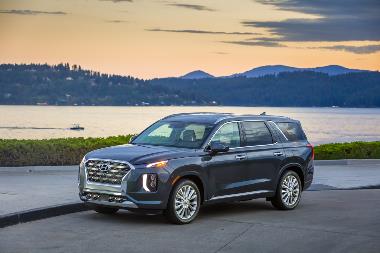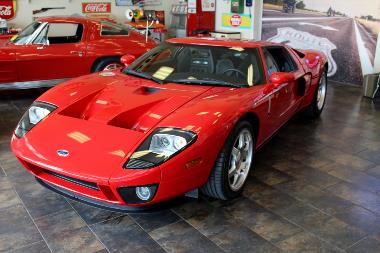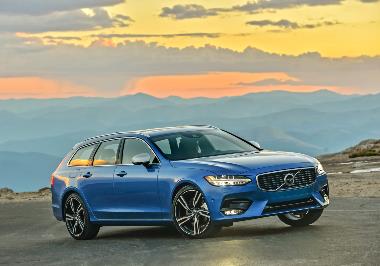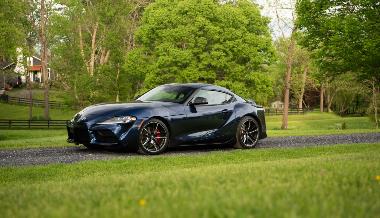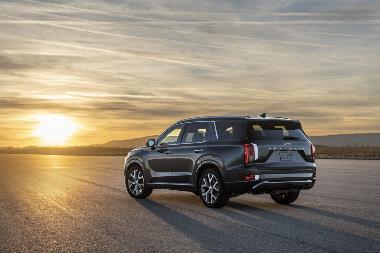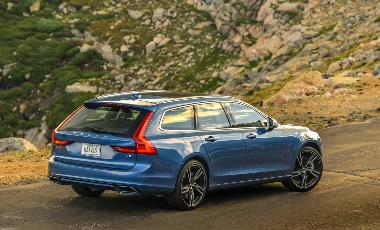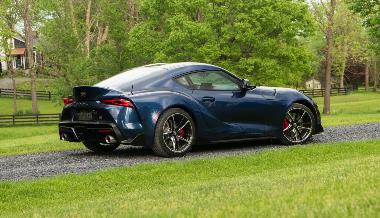The sexy, sporty Toyota Supra began as a longer and wider derivative of the Toyota Celica line-up in 1978, and by 1986, for its third generation, became its own stand-alone model. From the beginning, its inherent sportiness and turbo power captured the public’s imagination. After a four-generation run, Supra was discontinued in 2002, but it came back to life in May 2019.
The Supra line has been reincarnated as the GR, or GR Supra Racing Concept that is track-ready, but street legal, and features a lowered suspension with Toyota OEM parts, center-lock racing wheels, Brembo racing calipers, a full roll cage and fire extinguisher system, a stripped-out interior, Michelin track tires and a center exit racing exhaust. It also features carbon fiber for the hood, splitter, diffuser, mirror caps, side skirts, wing and bumpers.
Toyota embraces its racing heritage with the GR Supra as “GR” stands for Gazoo Racing -- Toyota's performance partner, and in the car builder’s marketing campaign for Supra: “This Is Our Sport”. Toyota Marketing Group Vice President Ed Laukes, said, “…2020 GR Supra (offers a) rediscovered appreciation for the simple joy of driving.”
Available in three trims: 3.0, 3.0 Premium and Launch Edition, I tested the fully loaded 3.0 Premium with12-speaker 500-watt JBL HiFi Surroundsound system, 8.8-inch Touch-Screen With Supra Command -- Featuring Touchpad Control With Navigation, AM/FM, Digital Audio, SiriusXM®, Wireless Apple CarPlay® Compatible, Voice Recognition and USB /Bluetooth Connectivity, Full-Color Head-Up Display, Qi-Compatible Wireless Charging Tray With Light Indicator, heated Black Leather-trimmed sport seats, wireless charging and tons of connectivity from Toyota Supra Connect®, featuring Emergency Calling, Battery Guard, Remote Control Lock/Ventilation, Real-Time Traffic Information, Map Updates, Concierge Service, and Toyota Supra Online (Services Available Online; App Available for iOS Only).
Supra’s look is curvy, sexy and sporty with some architectural influence by BMW and maybe old Z-Cars. In fact, Supra shares a platform with BMW and shows off a wide track and short wheelbase. At 172.5 inches long, 73 inches wide, a road-hugging 50.9 inches high, and a ground clearance of only 4.5 inches, on a compact 97.2-inch wheelbase, Supra is super friendly with the road. With a curbweight of 3397 pounds, Supra has a power-to-weight ratio of 10.14. Now, that 4.5-inch ground clearance means this is a fit-like-a-glove, slide-in-low car. If you are tall, you have to limbo into it, but being of average height, easing into the front seat begins the sensual pleasure of Supra driving.
Exterior highlights include six lens auto-leveling LED headlights (three low-beam, three high-beam), built-in rear spoiler, dual rear exhaust outlets with brushed stainless steel exhaust tips, LED backup light, LED front turn signal indicator and daytime running lights, and LED taillights and rear combination lights.
Power comes from Supra’s direct-injection 3.0-liter twin-scroll single-turbo DOHC engine. The 24-valve inline six-cylinder engine produces 335hp and 365 lb-ft of torque, and has been rated at 24mpg/city, 31mpg/highway and 26mpg/overall – I averaged 27.1 mpg in mixed-use, hammer-down testing. The engine is mated to an 8-speed automatic transmission with paddle shifters as well as manual mode, but there is no traditional manual transmission. Man, I would have liked to have a stick in this beast. What fun that would have been; however, even in automatic, Supra is super.
Going full out on autocrosses and within legal highway constraints, the road grip was superb, the engine is throaty (even a bit noisy in the cabin), and corners well, though high-speed hairpins cause the rear to wag out at times. And Supra’s double-joint-type MacPherson strut front suspension works well with a multi-link independent rear suspension to smooth out rough surfaces and still provide good driver’s road feel.
The manufacturer proclaims zero-to-60mpg times of 4.1 seconds, but my test ride did better than that, and I finished off the sprint in 3.9 seconds, during a 12.4-second quarter-mile.
The cabin is loaded with such niceties as a 14-way power-adjustable sport seat with driver's-seat memory function and lumbar and bolster adjustment, auto-dimming driver's-side outside mirror, automatic rain-sensing windshield wipers, dual zone automatic climate control, smart key system with smart entry and start, large knee support cushions and leather-wrapped 3-spoke steering wheel. The coupe’s interior dimensions are 38.3 inches of headroom, 54.4 inches of shoulder room and 42.2 inches of legroom.
Safetywise, you get Toyota’s Driver and Front Passenger Advanced Airbag System with front, side, curtain and knee airbags. And Supra provides Tire Pressure Monitor System, Anti-Lock Brake System, automatic high beams, directional parking lights, Lane Departure Warning with Steering Assist, Pre-Collision System with Pedestrian Detection, Rearview Camera with Parking Aid Lines, Traction Mode and Vehicle Stability Control
The 2020 Toyota GR Supra 3.0 starts at $49,990; the GR Supra 3.0 Premium goes $53,990 and the GR Supra Launch Edition starts at $55,250. My 3.0 Premium test ride in Nocturnal Black, and Black Leather-trimmed interior, added the $1195 Driver Assist Package with Dynamic Radar Cruise Control, Blind Spot Monitor, Rear Cross-Traffic Alert, Parking Sensors with Emergency Braking Functions and 50-state emissions compatibility. That’s all the extras needed as it was loaded by the manufacturer. The Delivery, Processing and Handling Fee was $995, for a sticker-as-tested of $56,140.
> Visit www.CarlisleEvents.com for more on the automotive hobby.
Mike Blake, former editor of KIT CAR magazine, joined Carlisle Events as senior automotive journalist in 2004. He's been a "car guy" since the 1960s and has been writing professionally for about 30 years. </I>
